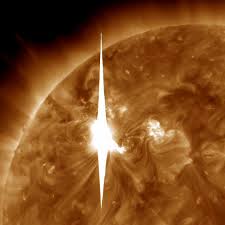
新型太阳风暴预报系统
Improved Solar Storm Tracking Lengthens Prep Time for Tech Disruption
新型太阳风暴预报系统
We currently have a maximum of about 60 minutes to prepare for tech disruptions on Earth due to coronal mass ejections from the sun, but an improved forecasting system could lengthen that lead time by hours. Maria Temming reports
目前我们至多只有60分钟的时间还预防日冕物质抛射引发的科技损害,但一种新型太阳风暴预报系统可以让准备时间延长数小时。
撰文/播音 玛丽亚·泰明(Maria Temming)
翻译 李轩
Our sun has a nasty habit of spitting volatile material at us. These incredibly hot bubbles of magnetized material are called coronal mass ejections, or CMEs. And they can hurtle towards Earth at thousands of miles per second.
我们太阳有一个令人讨厌的习惯,它会经常向我们抛射不稳定粒子。这些灼热的磁性物质被称为日冕物质抛射(coronal mass ejections, CMEs)。它们会以每秒数英里的速度冲向地球。
If one of a CME’s magnetic fields is aligned in just the wrong way when the ejection reaches Earth, it could cause a magnetic storm that can temporarily disrupt the planet’s magnetic field. Such a storm has the potential to wreak havoc on technologies like GPS satellites and utility grids, messing up radio transmissions and causing blackouts.
如果日冕物质抛射的磁场方向不合适,它就会在到达地球时引发磁场风暴,严重妨碍地球的原磁场。这会使GPS卫星、通信网络等人类科技面临被损毁的风险,还会影响无线电广播,以及引发停电。
Currently, satellites can only tease out the orientations of magnetic fields inside an approaching CME when it’s already closing in on Earth. We’d have about an hour’s notice of an impending space storm—hardly enough time for anyone to take the necessary protective measures.
目前,卫星只能在带电粒子流接近地球时确认其磁场方向,人类只有1小时的时间来准备应对即将到来的宇宙风暴——没有人能在这么短的时间内及时采取必要措施。
But a team led by space scientist Neel Savani, of NASA and the University of Maryland, have developed a new technique that might be able to give us a lot more lead time. Their model uses observations of the CME’s magnetic field orientations during the initial eruption and as it careens toward Earth—which can offer clues about what those orientations will be when they get here. The researchers describe their work in the journal Space Weather. [Neel Savani et al, Predicting the magnetic vectors within coronal mass ejections arriving at Earth: 1. Initial architecture]
但是一个由NASA及马里兰大学的空间科学家Neel Savani领导的团队发明了一种新技术,可能可以让我们有更多的准备时间。他们通过比较粒子束在刚产生时以及到达地球时的磁场方向,发现了一些粒子流磁场方向变化方式的线索。研究人员在《空间气象》期刊上发现了他们的成果。
Savani has already tested out his model’s predictive power on eight mass ejections. He claims significant improvement over current forecasting systems. At the very least, better advance warning would give people more time to finally back up their hard drives before the grid goes down.
Savani的模型已经成功预测了8次物质抛射。他的这一成果是现今预报系统的重大突破。最起码,这让人们有了充足的时间来备份自己的重要数据。
(题图来源:2eyeswatching.com)
未经书面许可任何人不得复制或镜像
京ICP备11000850号
 京公网安备11010502039775号
京公网安备11010502039775号 信息网络传播视听节目许可证0111611号
国家科技基础条件平台

















